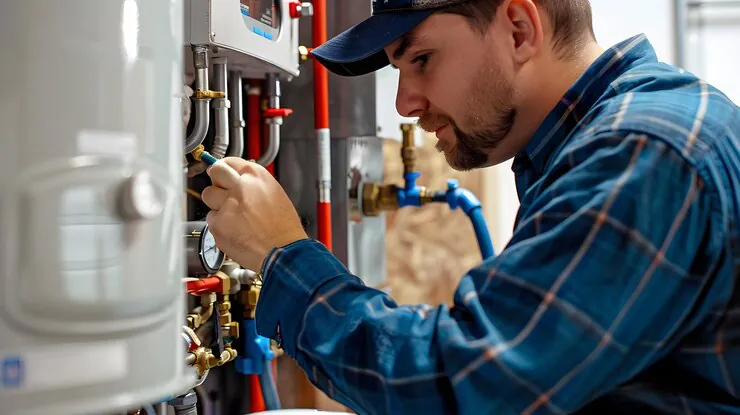Installing a heating system is one of the most significant investments you’ll make in your home, ensuring comfort during the cold months. Whether you’re replacing an old system or installing a new one in a recently built home, there are several factors you need to consider to make sure the installation process is smooth, efficient, and yields long-term results. In this guide, we’ll take you through everything you need to know before beginning your heating installation project, from understanding different heating system types to selecting the right contractor.
Table of Contents
- Understanding the Types of Heating Systems
- Assessing Your Home’s Heating Needs
- Energy Efficiency
- The Importance of Proper Sizing
- Choosing the Right Contractor
- Understanding Installation Costs
- The Installation Process
- Conclusion: Houston, TX Heating Installation by KAC Express
1. Understanding the Types of Heating Systems
Before diving into the installation process, it’s crucial to know the different types of heating systems available. The right one for your home will depend on several factors, including your budget, home size, and energy efficiency needs. Here are the main types:
- Furnaces: Furnaces are the most common type of heating system in the U.S. They can run on gas, oil, or electricity and work by heating air and distributing it through ducts into the rooms of your home.
- Heat Pumps: Heat pumps work by transferring heat from outside to inside during the winter. They can also reverse the process to cool your home in the summer, making them a versatile option for year-round use.
- Boilers: Boilers heat water and distribute it as hot water or steam through radiators or radiant floor systems.
- Ductless Mini-Splits: These are great for homes without ductwork, offering flexibility with individual room temperature control.
2. Assessing Your Home’s Heating Needs
The size and layout of your home will largely dictate the type of heating system you need. A properly sized unit will run efficiently, while one that’s too large or too small can lead to inefficiencies and higher energy bills. Here’s what to consider:
- Home Size: The size of your home is the most important factor when choosing a heating system.
- Insulation Levels: Good insulation prevents heat loss and reduces the size and cost of the heating system.
- Local Climate: Consider your climate. For moderate areas, heat pumps work well, but colder areas may need a furnace or boiler.
3. Energy Efficiency
Energy efficiency is critical in saving on utility bills and reducing environmental impact. Here’s what to look for:
- AFUE Rating: For furnaces and boilers, the Annual Fuel Utilization Efficiency (AFUE) rating indicates efficiency. The higher, the better.
- HSPF Rating: For heat pumps, the Heating Seasonal Performance Factor (HSPF) rating measures efficiency.
- Energy Star Certification: Systems with Energy Star certification meet strict energy efficiency guidelines.
4. The Importance of Proper Sizing
Choosing the right size heating system is essential for efficient operation. A system that’s too small will overwork, while an oversized system will cycle too often, causing wear and tear. A load calculation by an HVAC contractor will ensure you have the right-sized unit for your home.
See Also What to Expect During a Heating Installation
5. Choosing the Right Contractor
A successful installation depends on the expertise of the contractor. Here’s what to look for:
- Licensing and Certification: Ensure the contractor is licensed and certified to perform HVAC installations in your area.
- Experience: Look for contractors with a proven track record in heating system installation.
- Customer Reviews: Check reviews and testimonials to gauge customer satisfaction.
- Written Estimates: Get estimates from several contractors to compare prices and services.
6. Understanding Installation Costs
The cost of heating installation varies based on the system type and complexity. On average, homeowners can expect to pay between $3,000 and $7,000 for a new system. Here are some factors that affect costs:
- Equipment costs: This depends on the type and brand of the heating system you choose.
- Labor costs: These vary based on the complexity of the installation and contractor rates.
- Additional costs: Ductwork modifications, permits, and old equipment disposal can add to the total cost.
7. The Installation Process
Once you’ve chosen your system and contractor, the installation process begins. Here’s what to expect:
- Preparation: The contractor will assess your home to determine the best location for the system and any necessary ductwork or piping.
- Installation: The process depends on the type of heating system chosen and can take one to two days for furnaces and boilers.
- Testing: Once installed, the contractor will test the system to ensure it works correctly and efficiently.
Conclusion: Houston, TX Heating Installation by KAC Express
When it comes to heating installation in Houston, TX, KAC Express is your trusted partner for reliable, efficient service. We specialize in furnace, heat pump, and ductless mini-split installations, ensuring that your home stays warm and comfortable throughout the winter. Our team performs detailed load calculations to ensure the heating system is properly sized for your home’s needs.
At KAC Express, we’re committed to quality workmanship and customer satisfaction. If you’re ready to upgrade your home’s heating system, contact KAC Express today to schedule a consultation. We’re proud to serve the Houston, TX area with top-notch HVAC solutions for year-round comfort.



0 Comments